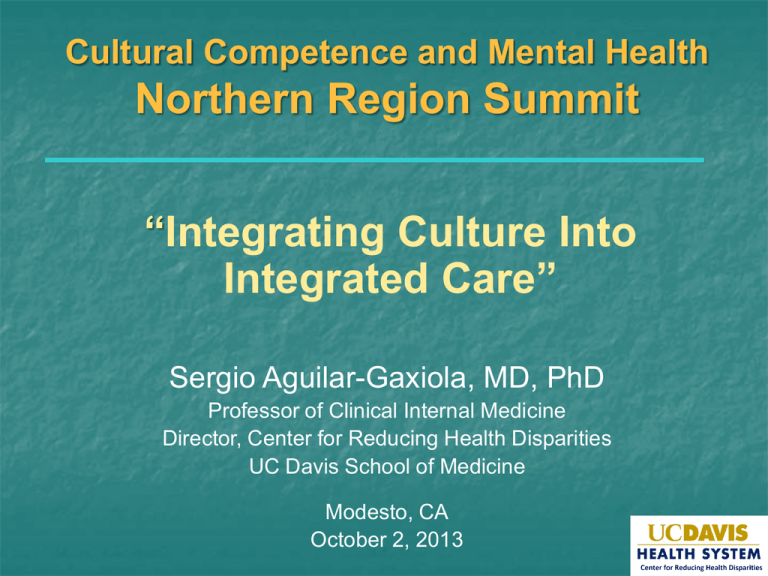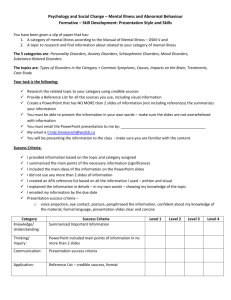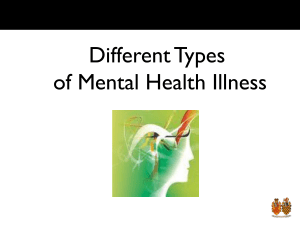Northern Region Summit “Integrating Culture Into Integrated Care” Cultural Competence and Mental Health
advertisement

Cultural Competence and Mental Health Northern Region Summit “Integrating Culture Into Integrated Care” Sergio Aguilar-Gaxiola, MD, PhD Professor of Clinical Internal Medicine Director, Center for Reducing Health Disparities UC Davis School of Medicine Modesto, CA October 2, 2013 Culture Influences Help Seeking Culture influences help seeking behaviors and attitudes toward health care providers Latinos have less access to mental health services are less likely to receive needed care, and are more likely to receive poor quality care when treated than do whites. Asian and Pacific Islanders tend to delay helpseeking which may be due mistrust of the system and language barriers. African Americans tend to rely on family, religious and social communities rather than turning to health care professionals. Culture is not talked about –- much of it is taken for granted (much like the air we breathe), and what is taken for granted is not discussed. Also, since culture is widely shared, it is uninteresting to talk about what everybody shares. This means, however, that people have little practice in discussing how culture affects their behavior, and so are ill-prepared to explain their culture to others. Levine, 2001 Let’s hear it from cultural sensitivity! Cultural Differences An office somewhere in South America… Hours of Operation 12 noon to 9:30 P.M. MORE or LESS Source: Levine, 2001 Culture Counts! “The main message of this Supplement— that culture counts—should echo through the corridors and communities of this Nation. In today’s multicultural reality distinct culture and their relationship to the broader society are not just important for mental health and the mental health system, but for the broader health care system as well.” Source: Culture, Race, and Ethnicity; A Supplement to Mental Health: A Report of the Surgeon General, 2001 Culture Counts! Culture influences: How people communicate and manifest their symptoms Their style of coping Their willingness to seek treatment Their family and community support Source: Culture, Race, and Ethnicity; A Supplement to Mental Health: A Report of the Surgeon General, 2001 Definition of Culture “Meanings, values, and behavioral norms that are learned and transmitted in society and within social groups.” Culture powerfully influences cognition, self-concept, feeling, and activities. Culture has a strong impact on diagnostic processes and treatment decisions. Source: Guarnaccia, 2006 Language also Counts! Language is the core medium for the communication, creation, and transmission of culture. “Given the centrality of talking as a major form of mental health treatment, issues of language and culture appear particularly central in thinking about developing culturally competent mental health services” (Guarnaccia, et al., 1998; p. 424) Why Culture and Language Matter in the Delivery of Health Services Culture patterns our thinking, feeling, and behavior in both obvious and subtle ways. Culture plays a major role in determining: what we eat; how we work; how we relate; how we celebrate holidays and rituals; how we feel about life, death, and illness; how we recognize, interpret, label, and respond to illness; how we express and report our concerns; how we seek help. Why Consider Culture and Language in Health Care Attention to culture and language and its impact on health care can: improve the quality of health care; add to our understanding of health care solutions among diverse cultural groups; encourage a more holistic approach to healthcare within individual, family, and community-based systems. Everyone has a culture… Source: Taylor, NCRR, 2007 Why is important to integrate primary care and mental health care? Some Eye Openers “People with serious mental illness served by the public mental health system die, on average, 25 years earlier than the general population.” NASMHPD Morbidity and Mortality in People with Serious Mental Illness October 2006 “Adults with serious mental illness treated in public systems die about 25 years earlier than Americans overall, a gap that’s widened since the early ‘90s, when major mental disorders cut life spans by 10 to 15 years…” “ USA Today, May 3, 2007 16 The Case for Integration 1. Comorbidities are the rule rather than the exception 2. Mental health in primary care: Primary care is the main point of service delivery entry and where the patients are. Primary care is the ‘de facto’ health care system for common mental disorders. 3. Medical care in mental health care settings: Patients with severe mental disorders (SMI) receive poor medical care and die on average 25 years earlier than those without SMI. Source: Unützer, 2010 Comorbidity Definition: the presence of more than one mental disorder within the same period of time. 41%–65% of those reporting a lifetime substance disorder had at least one other psychiatric disorder. 51% reporting one or more psychiatric disorders also reported at least one substance disorder. 23 % of those in the NCS sample had three or more lifetime disorders. Source: Kessler, 2004 Source: Unützer, 2010 GA-U = General Assistance – Unemployable Source: Unützer, 2010 Precursors, Manifestations and Consequences Childhood adversities may increase risks of early onset mental disorders, while both childhood adversities and early onset mental disorder may increase risks of a range of physical diseases in later life. Childhood Adversities Early Onset Mental Disorders Childhood Adversities + Mental Disorders Increasing Risk of Age-Related Chronic Conditions Source: Aguilar-Gaxiola , 2009; Simon, 2009 Why Look at Mental-Physical Comorbidities Almost half of the patients with diabetes identified in the Medi-Cal fee-for-service population had a co-morbid mental health condition, which may impair an individual’s ability to carry out diabetes-related selfmanagement tasks and compromise overall health. Medi-Cal fee-for-service beneficiaries (both with and without co-morbid mental health conditions) have lower rates of HbA1C and lipid panel monitoring in comparison with a national subset of Medicaid fee-for-service beneficiaries. Source: http://files.medi-cal.ca.gov/pubsdoco/dur/articles/dured_21476.asp Why Look at Mental-Physical Comorbidities Source: http://files.medi-cal.ca.gov/pubsdoco/dur/articles/dured_21476.asp Why Look at Mental-Physical Comorbidities Source: Table provided by Fingado, 2013 Where is Mental Health Care Received? Of people with poorer mental health in the US: 50% --- Only see a Primary Care Physician 17% --- No visits 13% --- See both Primary Care and Mental Health 5% --- Only See a Mental Health Provider Of those who see only primary care: 1/3rd will make only one visit Are more likely to have other health conditions Source: England and Phillips, 2006 Why Seek MH Care in Primary Care? Most people seek help for MH problems in PC settings ~1/2 of all care for common psychiatric disorders happens in PC settings Diverse populations are even more likely to seek or receive care in PC than in specialty MH settings Limited access to public MH services Cultural beliefs and attitudes Limited availability of MH services, especially in rural areas Source: Alexander, 2010 Overall Recommendations from the WHR 2001 Report Steps that nations can take to promote better mental health: 1. Provide treatment in primary care 2. Make psychotropic drugs available 3. Give care in the community 4. Educate the public 5. Involve communities, families, and consumers 6. Establish national policies, programs, and legislation 7. Develop human resources 8. Link with other sectors 9. Monitor community mental health 10. Support more research Benefits of Primary Care and Behavioral Health Integration As a first point of contact, primary care: Is closer to home or work and more affordable that specialty care Offers the possibility of cost-effective treatment, particularly with less severe mental disorders Has the potential for early identification of symptoms and for coordination and continuity of care for both mental and physical disorders Is perceived as less stigmatizing than specialty behavioral health settings Source: Report of a Surgeon General’s working meeting on the integration of mental health services and primary health care; 2000 Integrated Health Care Integrated health care is the systematic coordination of physical and behavioral health care. The idea is that physical and behavioral health problems often occur at the same time. It seeks to improve people's health by treating their physical and behavioral illnesses together. Source: Hogg Foundation for Mental Health, Connecting Body & Mind: A Resource Guide to Integrated Health Care in Texas and the U.S., www.hogg.utexas.edu Where to begin? Integrated models begin with integrated concepts An Integrated Concept “Dealing equally with health care for mental, substance-use and general health conditions requires a fundamental change in how we as a society and health care system think about and respond to these problems and illnesses. Mental and substance-use problems and illnesses should not be viewed as separate from and unrelated to overall health and general health care.” Harvey V. Fineberg, M.D., Ph.D. President, Institute of Medicine Mental, Substance-Use, & General Health CONCLUSION Improving care delivery and outcomes for any one depends upon improving care and outcomes for the others. OVERARCHING RECOMMENDATION Health care for general, mental, and substance-use problems and illnesses must be delivered with an understanding of the inherent interactions between the mind/brain and the rest of the body. Bidirectional Integration Integrating PC services into MH/SU settings AND Integrating MH/SU services into PC settings In both cases, the services are not just provided, but coordinated with other care delivered in that setting Source: Alexander, 2010 How do you approach a consumer from a different culture in primary care? 1. You may have had a chance to learn about, or cared for consumers from a certain community or country (i.e. recent immigrant group or an international patient) 2. You may have no clue…then what?? Be aware of key issues, and observe, and ask. Cross-Cultural Education: Training Needs Skills for working with diverse patients with different conceptualizations about health and health care. Skills on how to use interpreters. Case-based learning. Cross-Cultural Education: Challenges Difficult to learn about all cultures Difficulty speaking the patient’s language Limited amount of time with patients Complexity of issues Cross-Cultural Care: A Patient-Centered Approach 1. Assess core cross-cultural issues 2. Explore the meaning of the illness 3. Determine the social context 4. Engage in negotiation The Clinical Encounter Patient’s Input •Words •Expressions of distress •Affects •Beliefs •Health literacy Clinician’s Understanding and Comprehension Accurate Diagnosis Adequate Treatment The Clinical Encounter Patient’s Input •Words •Expressions of distress •Affects •Beliefs •Health literacy Clinician’s Understanding and Comprehension Misdiagnosis No treatment or inappropriate Treatment Prolonged Client’s Suffering and Increased Medical Costs Meaning of the Illness: Identifying Explanatory Models Consumer’s conceptualizations of illness Consumer’s ideas about diagnostic procedures or treatments Explanatory Model Questions 1. What do you think has caused your problem? How? 2. Why do you think it started when it did? 3. How does it affect you? 4. What worries you most? Severity? Duration? 5. What kind of treatment do you think you should receive? What result do you expect? Consumer-Provider Negotiation Consumer’s model Biomedical model Mutual understanding Improved adherence Source: Miller, 2005 ETHNICS Mnemonic: A Framework for Culturally Appropriate Care Explanation: why do you have this problem? Treatment: what have you tried for it? Healers: who else have you sought help from? Negotiation: how best do you think I can help you? Intervention: this is what I think needs to be done. Collaboration: how can we work together on this? Spirituality: what role does spirituality play in this? Kobylarz, Heath, Like. The Etnics Mnemonic: A Clinical Tool for Ethnogeriatric Education. J Am Geriatr Soc 2002; 50: 1582-89 Opportunities for Integrated Care Integrated care as a health delivery concept continues to gain momentum nationwide, attracting widespread attention throughout the health services community. Health care reform and parity legislation offer real opportunities for the successful implementation of innovative integrated care models. Integrated, or collaborative, care can change the current practice structure for mental health providers and provide a vehicle for payment reform that will benefit the entire behavioral health team. Source: http://www.psych.org/MainMenu/AdvocacyGovernmentRelations/FinancingHealthcare/Integrated-CareResources.aspx Source: Unützer, 2010 Collaborative Care’s Key Ingredients Primary care providers Care managers – Patient education & empowerment, ongoing monitoring, care/provider coordination Expert consultation (psychiatrists) for patients who are not improving Evidence-based treatments – Effective medication management, psychotherapy Systematic diagnosis and outcome tracking Stepped care Technology support – registries Source: Unützer, 2010 Collaborative Care’s Key Ingredients A notable key ingredient is absent The Consumer/Patient We need to actively engage the consumer/patient and his or her family Hot of the press! February issue of Health Affairs How do people receiving integrated services feel about their care? Consumers receiving integrated services report higher quality of life and greater satisfaction with: ▬ Access ▬ Attention to their treatment preferences ▬ Courtesy ▬ Coordination & continuity of care ▬ Overall care Source: Alexander, 2010; Druss et al, Arch Gen Psychiatry. 2001; Unutzer et al, JAMA. 2002; Ell et al, Diabetes Care. 2010. The Health Care Law In March 2010, President Obama signed into law the Affordable Care Act (ACA) The Health Care Law is a Reality Now! The Health Care Law is a Reality Now! CARE INTEGRATED \ Health Care Reform Healthcare reform legislation has linked the ability to demonstrate quality outcomes with managing costs. Universal coverage, delivery system design, and payment reform make bidirectional integration of MH/SU services with healthcare more important than ever before, especially in systems that historically have served the safety net population. Delivery System Reform: MH/SUD & General Health Integration Medicaid health home option (2011) Definition of chronic condition determining eligibility for benefit includes MH and SUD Grants to support co-location of primary and specialty care in community behavioral health centers (2010) Grants for community health teams $50 million for co-location and grants for FQHCs By Jay Neugeboren Newsweek Source: Newsweek_February 6, 2006 issue. The Power of Connection… The Power to Heal: Due to the dedication of Dr. Pam, my brother has not had a recurrence for more than six years Jay Neugeboren What had made a difference? The Power of Meaningful Connections… “Robert telephoned. "Alan's leaving-Alan's leaving!" he kept screaming. Alan was my brother's social worker-a man to whom he was very attached and whom he had known for many years, from his longterm stay at another hospital.” Jay and his brother Robert After interviewing hundreds of former mental clients for a book, what made the difference was: Source: Newsweek_February 6, 2006 issue. “…they all -- every last one said that a key element was a relationship with a human being. Most of the time, this human being was a professional -- a social worker, a nurse, a doctor. Sometimes it was a clergyman or family member. In every instance, though, it was the presence in their lives of an individual who said, in effect, "I believe in your ability to recover, and I am going to stay with you until you do" that brought them back.” Jay Neugeboren “Imagining Robert: My Brother, Madness, and Survival” Source: Newsweek_February 6, 2006 issue. Words of Wisdom "Every [person] is in certain respects a. like all other [people], b. like some other [people], c. like no other [people]." Kluckhon & Murray, 1953







